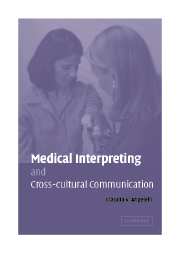Book contents
- Frontmatter
- Contents
- List of figures
- List of tables
- Acknowledgments
- List of abbreviations
- Prologue
- 1 Questioning invisibility
- 2 Communication in the medical encounter
- 3 A different set of lenses
- 4 California Hope: a public hospital in changing times
- 5 Putting it all together
- 6 Finding visibility
- 7 Interpreters' voices
- 8 Emerging metaphors and final words
- References
- Index
6 - Finding visibility
Published online by Cambridge University Press: 22 September 2009
- Frontmatter
- Contents
- List of figures
- List of tables
- Acknowledgments
- List of abbreviations
- Prologue
- 1 Questioning invisibility
- 2 Communication in the medical encounter
- 3 A different set of lenses
- 4 California Hope: a public hospital in changing times
- 5 Putting it all together
- 6 Finding visibility
- 7 Interpreters' voices
- 8 Emerging metaphors and final words
- References
- Index
Summary
I would argue that translation for the philologist – one who would guide us across the terra incognita between distant languages – is not the final goal, but only a first step, in understanding a distant text; necessary because it opens up for us the exuberances and deficiencies of our own interpretations and so helps us see what kinds of self-correction must be made.
A. L. Becker Beyond Translation (1995:186)The nature of the ICE at California Hope
The ICEs at CH cover a range of activities and, as we have seen, occur either over the speakerphone or face-to-face. Patients or HCPs need interpreters to assist them in performing various activities and carrying out communicative functions. Examples of activities include: making or canceling an appointment; delivering news or results; conducting a verbal examination (speech pathology); conducting a physical examination (physician); conducting a procedure (e.g. CT scan); and calling to remind about an appointment. In these activities, any of the following communicative functions can occur: complain, request, reprimand; explain, express support, justify, advise; ask and answer questions, express solidarity; instruct; inform; and remind. The length of the ICE also varies significantly, according to the nature of the event (which varies from two minutes to over two hours). For example, an appointment cancellation or a reminder call may take under three minutes. These ICEs are generally conducted over the telephone. A check-up visit may take fifteen minutes, with the interpreter present or at a remote location (over the speakerphone).
- Type
- Chapter
- Information
- Medical Interpreting and Cross-cultural Communication , pp. 73 - 104Publisher: Cambridge University PressPrint publication year: 2004

